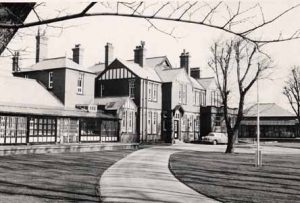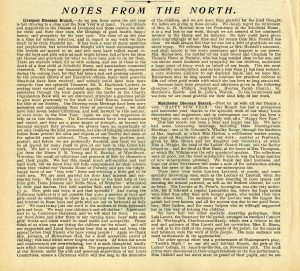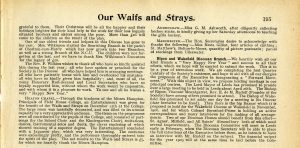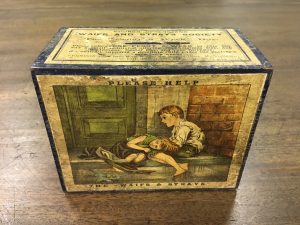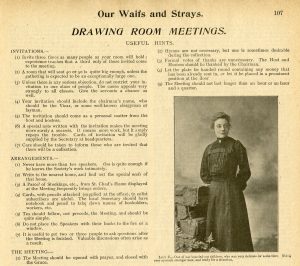Another in the series of our blogs – written by one of our volunteers, Rod Cooper – that takes a look at the history of raising money for The Children’s Society’s.The following article is one of two looking at the fundraising efforts made by a local branch of the Waifs and Strays Society in the early years of the twentieth century.
In the early years of the twentieth century The Children’s Society, or to give it its full name at the time, the Church of England Incorporated Society for Providing Homes for Waifs and Strays, was very much a devolved organisation, mirroring and established upon an existing template of regional dioceses. Among these, one of the largest, most active and arguably most independent was the Liverpool Branch Diocese.
By the turn of the century, the Branch organised and oversaw the running of four homes – the Victoria Home in Formby (established for infants); St George’s Home in Warrington (boys); the Scholfield Home in Wavertree (girls) and Elm Lodge at Seaforth (boys). In addition to these, the Liverpool Diocese, through their own funds and energies – and with continued support from the Children’s Union – built and ran the Bradstock Lockett Home for disabled children at Southport.
Understandably, the homes would have presented the most obvious areas of expenditure for the Branch, but it’s important to mention that boarding out – always strongly supported by the Waifs and Strays Society – necessitated considerable financial support too.
Just as it is with The Children’s Society today, it was apparent to the Waifs and Strays Society that in order to be effective, it could not succeed by simply relying on good intentions. By necessity financial support, a constant flow of donations and the diligent management of funds, were essential.
However, in the early years of the twentieth century, matters were not as would have been hoped by the Branch Committee. In the twelve months to mid-1905, for example, the funds raised by the Branch amounted to almost three-and-a-half thousand pounds (the equivalent of £390,000 today). Yet in the same period, however, expenses exceeded income by almost one hundred pounds. This may not seem a great deal, but when added to the Branch’s accumulated deficit it clearly troubled the organising committee. By 1905, this deficit stood at £510 (almost £57,000 by today’s values); “an alarming amount and passes beyond the realms of a ‘manageable deficit’.” (‘Notes From the North’, Our Waifs and Strays, May 1905). This was clearly a problem: “The question uppermost in our minds is how is it going to be with us financially this year? We hope, with the great efforts that are being put forth, we may turn the corner and begin to see that wretched debit balance materially reduced.”
Successive copies of Our Waifs and Strays – the monthly magazine of the Waifs and Stray Society – archived at The Children’s Society’s Bermondsey-based Records Centre, illustrate some of the problems local branches had at this time. The monthly returns for donations listed in the magazine show two significant and quite related problems: widely varying monthly receipts and a reliance on numerous small and unpredictable donations. In fairness however, this latter point was something of a strength too, as it reflected the breadth and depth of The Society’s reach throughout the Church of England’s diocesan and parish network. Nonetheless, donations varied from one month to the next, and throughout the year, and this militated against efficient financial planning for much beyond the short-term.
Funds coming into the Liverpool Branch arrived from numerous sources and in varying amounts. Occasionally these would be fairly substantial, but the overwhelming majority were very small. Among the latter, and attracting commentary in ‘Notes From the North’ were “Irene Johnson and Nellie Shaw, of Waterloo, [who] held a small Sale of Work among their little friends, and sent Canon Dickson 3s. 6d. [i.e., almost 18 pence] as the result of their efforts. That 3s. 6d. is as precious as the gifts of gold of their elders, as it evinces a real interest and earnest desire to help us.” (OWS, December 1905)
Small contributions dominate the lists of monthly donors. In addition to Sales of Work (typically small hand-made, hand-stitched items), small sums also accrued from numerous box collections, or from church collections – listed as “offertories” – following sermons related to the work of the Waifs and Strays Society. Boxes – literally small, wooden collection boxes – were a very popular means of raising funds, and many of these were held and returned by members of the Society, such as local branch secretaries, for example. Some, however, were positioned in local railway stations, or cafes and restaurants, where passing members of the public could donate any spare coins. The February and March 1905 issues of Our Waifs and Strays, for example, list donations from Formby Station (the equivalent of 85 pence), Ormskirk Station (60 pence), and the Mecca Café (35 pence). The March issue also lists, among others, the Servants at Larkfield (45 pence).
Entertainments of various sorts – recitals, amateur dramatics, magic lantern shows, etc. – also proved to be a popular form of fund raising. In Notes From the North (OWS, March 1905) it is reported that the Doric Amateur Dramatic Society presented two performances of “The Little Nautch Girl” at Knotty Ash village hall, whilst the Green Room Amateur Dramatic Society put on “Masks and Faces” at Sefton Park. The Green Room Amateur Dramatic Society must have proved quite a draw as the January 1906 issue of Our Waifs and Strays lists a donation of £80, 13s. 3d. – the equivalent of almost £9,000 at today’s value. At the other end of the scale, two magic lantern lectures at Bickerstaffe totalled a contribution only slightly in excess of £2 (OWS, March 1905). A less common, but nonetheless effective form of fund-raising venture was a ball. By definition almost exclusively an activity limited to the relatively wealthy and well-connected, balls had the possibility of raising relatively large funds. The Formby Ball held by Mrs Beaufort in the New Year for example, raised more than £64 for The Society (OWS, March 1905).
Another form of fund-raising practised by those ‘in society’ was the Drawing Room Meeting. These tended to be held in the autumn and winter months and, almost by definition, required the resources of those with sufficient room and means to accommodate and cater for small-, or medium-sized, audiences. Moreover, to attract the appropriate audience and speakers, good connections were also necessary. The January 1906 issue of Our Waifs and Strays, cites contributions from at least half-dozen drawing room meetings staged over the previous few weeks; including, Mrs Patterson at West Derby (£20.80), Mrs Brown at Birkdale (£4.75), and Mrs Denbigh at Blundellsands (£3.75). In total the funds raised during the month amounted to present-day equivalent of over £5,000 – simply by people making their own homes available for just a few hours, for the benefit of The Society.
But what was a Drawing Room Meeting? They typically lasted not much more than an hour and, as well as a guest speaker, they were usually attended by the local vicar or well-known clergyman. Whilst details of the subjects discussed can only be speculated upon there would undoubtedly have been a strong Christian and moralistic theme. The June 1903 issue of Our Waifs and Strays carries some “Useful Hints” on holding such meetings. There isn’t room here to repeat these in full, but quoting a handful – some being quite direct and pragmatic, some being clearly of another age – provides a flavour of what was entailed:
Invitations:
(1) Invite three times as many people as your room will hold; experience teaches that a third only of those invited come to the meeting.
(2) A room that will seat 40 or 50 is quite big enough, unless the gathering is expected to be an exceptionally large one.
(3) Unless there is any serious objection, do not restrict your invitation to one class of people. The cause appeals very strongly to all classes. Give the servants a chance as well.
Arrangements:
(1) Never have more than two speakers. One is quite enough if he [sic] knows the Society’s work intimately.
The Meeting:
(2) Hymns are not necessary, but one is sometimes desirable during the collection.
(4) Let the plate be handed round containing any money that has already been sent in, or let it be placed in a prominent position at the door.
Drawing Room Meetings, Boxes, Sales of Work and various forms of entertainments, would remain popular forms of fund-raising at the grassroots level for many years to come. But these were not the only means of raising funds, and in the second part of this this article a major element of the Liverpool Diocese’s fund-raising activities – The Silver Thimble League – will be looked at. Established at the local level, this initiative was so successful that by the 1930s it was established on a national scale as The Golden Thimble League.
Scanned copies of the Our Waifs and Strays magazine can be found here: http://www.hiddenlives.org.uk/publications/waifs_and_strays/index.html
Scanned copies of the Brothers and Sisters magazine can be found here: http://www.hiddenlives.org.uk/publications/brothers_and_sisters/index.html
Records featured in this blog are held at The Children’s Society Archive:
- for information about The Children’s Society Archive’s ‘Hidden Lives Revealed’ web site: http://www.hiddenlives.org.uk/
- or you can consult the Archive’s on-line catalogue: http://www.calmview.eu/childrensociety/Calmview/
If you would would like to know about how The Children’s Society continues to change children’s lives today, visit the charity’s website: http://www.childrenssociety.org.uk/
© The Children’s Society

